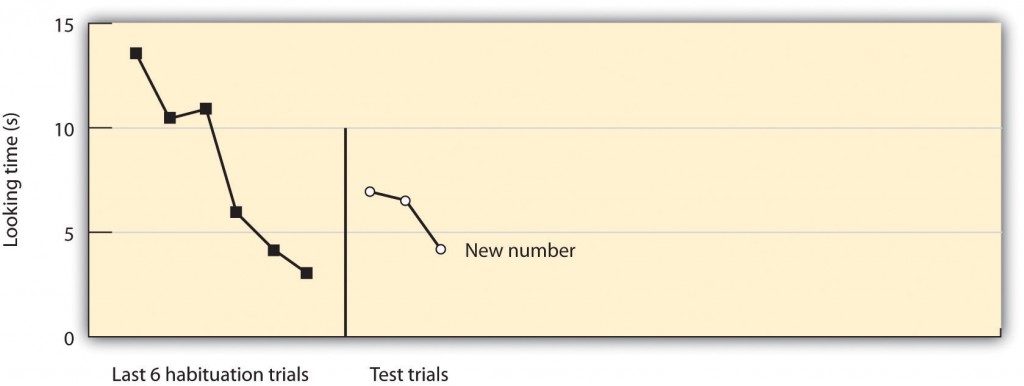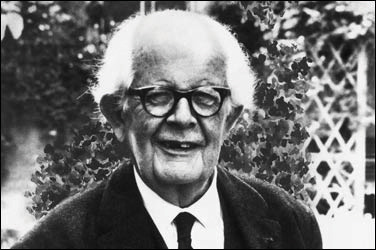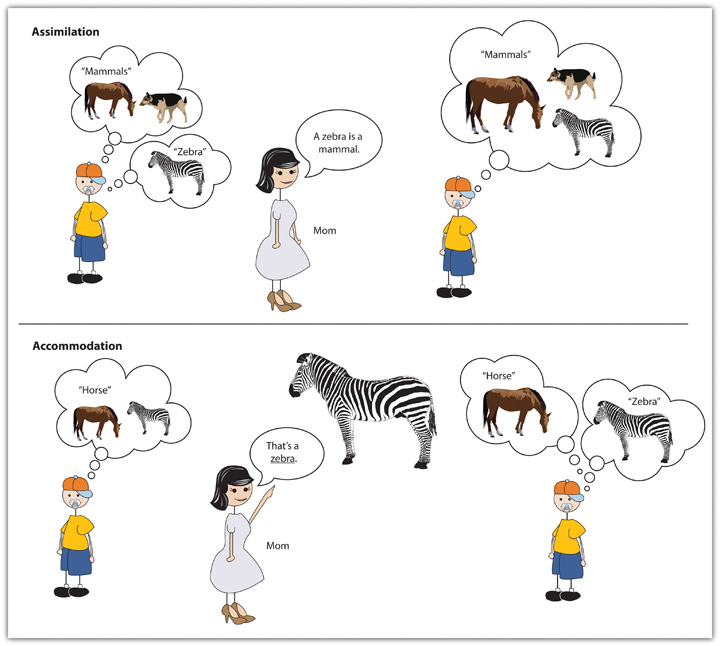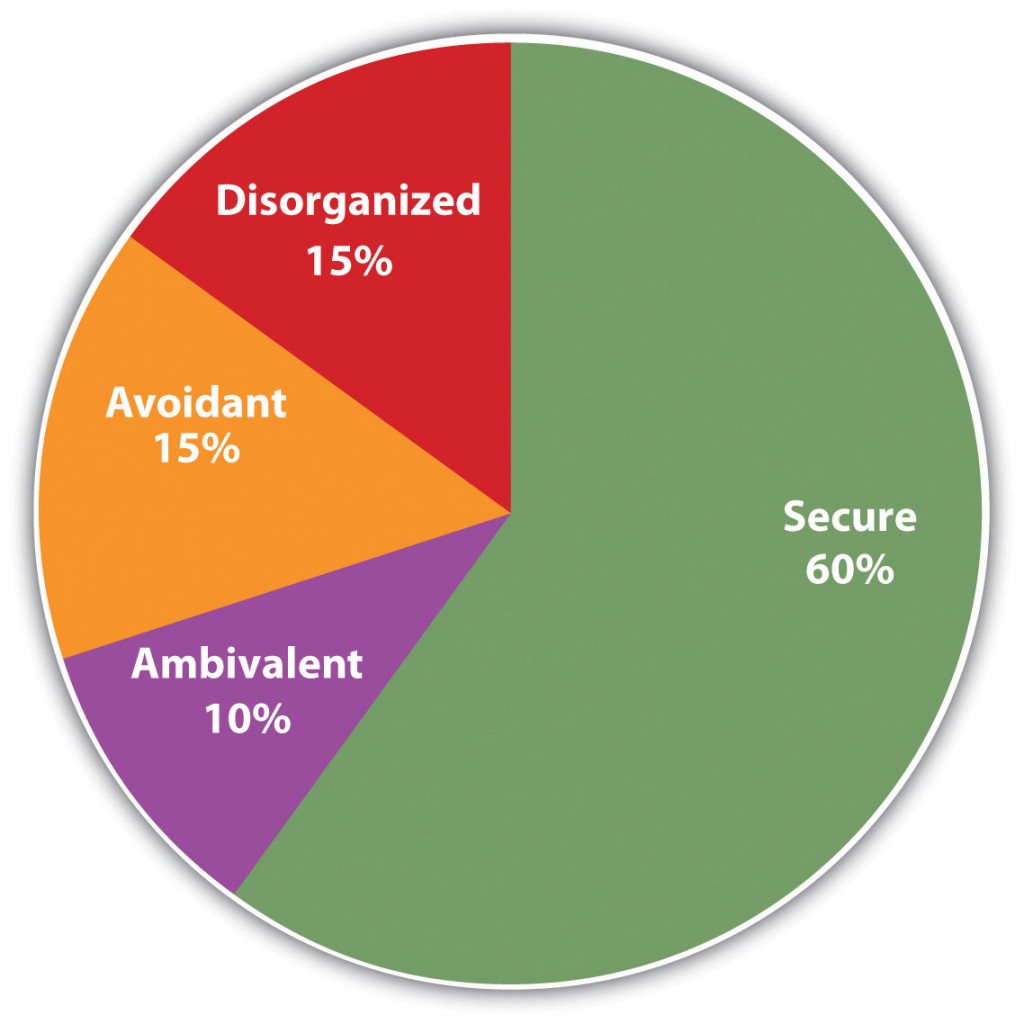Babies Are Born With a Set of Innate Knowledge Systems
Chapter 7. Growing and Developing
7.2 Infancy and Childhood: Exploring and Learning
Learning Objectives
- Describe the abilities that newborn infants possess and how they actively interact with their environments.
- List the stages in Piaget'south model of cognitive evolution and explain the concepts that are mastered in each stage.
- Critique Piaget's theory of cognitive development and describe other theories that complement and expand on it.
- Summarize the important processes of social development that occur in infancy and childhood.
If all has gone well, a baby is born erstwhile around the 38th calendar week of pregnancy. The fetus is responsible, at least in part, for its own birth because chemicals released by the developing fetal encephalon trigger the muscles in the female parent's uterus to beginning the rhythmic contractions of childbirth. The contractions are initially spaced at about xv-minute intervals just come more rapidly with fourth dimension. When the contractions reach an interval of two to three minutes, the female parent is requested to assist in the labour and help button the baby out.
The Newborn Arrives With Many Behaviours Intact
Newborns are already prepared to face the new world they are about to experience. As yous can see in Table vii.two, "Survival Reflexes in Newborns," babies are equipped with a variety of reflexes, each providing an ability that will help them survive their get-go few months of life as they proceed to acquire new routines to aid them survive in and dispense their environments.
| [Skip Table] | ||||
| Name | Stimulus | Response | Significance | Video Instance |
|---|---|---|---|---|
| Rooting reflex | The baby's cheek is stroked. | The baby turns its head toward the stroking, opens its mouth, and tries to suck. | Ensures the infant's feeding will be a reflexive habit | Spotter "The Rooting Reflex" [YouTube] |
| Blink reflex | A lite is flashed in the baby's eyes. | The baby closes both eyes. | Protects eyes from strong and potentially unsafe stimuli | Watch "Infant Blinking" [YouTube] |
| Withdrawal reflex | A soft pinprick is applied to the sole of the baby's foot. | The baby flexes the leg. | Keeps the exploring infant away from painful stimuli | Sentinel "Baby Withdraw Reflex" [YouTube] |
| Tonic neck reflex | The infant is laid down on its dorsum. | The infant turns its head to ane side and extends the arm on the same side. | Helps develop hand-middle coordination | Watch "Tonic Neck Reflex" [YouTube] |
| Grasp reflex | An object is pressed into the palm of the baby. | The babe grasps the object pressed and can even hold its own weight for a brief period. | Helps in exploratory learning | Watch "Grasp reflex" [YouTube] |
| Moro reflex | Loud noises or a sudden drop in height while holding the infant. | The infant extends arms and legs and quickly brings them in as if trying to grasp something. | Protects from falling; could have assisted infants in holding on to their mothers during rough travelling | Watch "Moro Reflex" [YouTube] |
| Stepping reflex | The babe is suspended with bare anxiety just above a surface and is moved forwards. | Baby makes stepping motions every bit if trying to walk. | Helps encourage motor development | Watch "Stepping Reflex" [YouTube] |
In add-on to reflexes, newborns have preferences — they similar sweet-tasting foods at first, while becoming more than open to salty items by four months of historic period (Beauchamp, Cowart, Menellia, & Marsh, 1994; Blass & Smith, 1992). Newborns also adopt the smell of their mothers. An infant but six days old is significantly more than likely to turn toward its own female parent's breast pad than to the breast pad of another baby'southward female parent (Porter, Makin, Davis, & Christensen, 1992), and a newborn also shows a preference for the confront of its own mother (Bushnell, Sai, & Mullin, 1989).
Although infants are born ready to engage in some activities, they also contribute to their own development through their own behaviours. The kid's knowledge and abilities increase as information technology babbles, talks, crawls, tastes, grasps, plays, and interacts with the objects in the surroundings (Gibson, Rosenzweig, & Porter, 1988; Gibson & Pick, 2000; Smith & Thelen, 2003). Parents may help in this process past providing a variety of activities and experiences for the child. Research has found that animals raised in environments with more novel objects and that appoint in a diversity of stimulating activities have more encephalon synapses and larger cerebral cortexes, and they perform better on a variety of learning tasks compared with animals raised in more impoverished environments (Juraska, Henderson, & Müller, 1984). Similar effects are likely occurring in children who have opportunities to play, explore, and interact with their environments (Soska, Adolph, & Johnson, 2010).
Enquiry Focus: Using the Habituation Technique to Study What Infants Know
It may seem to you that babies have little ability to view, hear, understand, or recollect the world around them. Indeed, the famous psychologist William James presumed that the newborn experiences a "blooming, buzzing confusion" (James, 1890, p. 462). And you may remember that, even if babies practice know more than James gave them credit for, information technology might not be possible to detect out what they know. After all, infants can't talk or respond to questions, and then how would we e'er find out? But over the past two decades, developmental psychologists have created new ways to determine what babies know, and they have found that they know much more than you, or William James, might take expected.
One fashion that nosotros can learn about the cognitive development of babies is past measuring their behaviour in response to the stimuli around them. For instance, some researchers take given babies the take a chance to command which shapes they go to see or which sounds they go to hear according to how hard they suck on a pacifier (Trehub & Rabinovitch, 1972). The sucking behaviour is used as a measure of the infants' involvement in the stimuli — the sounds or images they suck hardest in response to are the ones nosotros can assume they prefer.
Some other approach to understanding cognitive development past observing the behaviour of infants is through the use of the habituation technique. Habituation refers to the decreased responsiveness toward a stimulus subsequently it has been presented numerous times in succession. Organisms, including infants, tend to be more than interested in things the start few times they experience them and become less interested in them with more frequent exposure. Developmental psychologists have used this general principle to help them understand what babies remember and understand.
In the habituation procedure,[1] a baby is placed in a high chair and presented with visual stimuli while a video photographic camera records the baby'south eye and face movements. When the experiment begins, a stimulus (e.1000., the face of an adult) appears in the baby'due south field of view, and the amount of fourth dimension the baby looks at the face is recorded by the camera. And so the stimulus is removed for a few seconds before information technology appears again and the gaze is once again measured. Over time, the babe starts to habituate to the confront, such that each presentation elicits less gazing at the stimulus. Then a new stimulus (east.g., the face of a different adult or the same face looking in a dissimilar direction) is presented, and the researchers observe whether the gaze fourth dimension significantly increases. You lot tin see that if the babe's gaze time increases when a new stimulus is presented, this indicates that the baby tin differentiate the 2 stimuli.
Although this procedure is very unproblematic, it allows researchers to create variations that reveal a cracking deal nearly a newborn'southward cerebral ability. The trick is simply to modify the stimulus in controlled means to run into if the baby "notices the departure." Enquiry using the habituation procedure has found that babies tin observe changes in colours, sounds, and even principles of numbers and physics. For instance, in i experiment reported by Karen Wynn (1995), six-month-sometime babies were shown a presentation of a puppet that repeatedly jumped up and down either two or three times, resting for a couple of seconds between sequences (the length of fourth dimension and the speed of the jumping were controlled). Afterward the infants habituated to this display, the presentation was changed such that the puppet jumped a unlike number of times. As you can see in Effigy vii.2, "Can Infants Practice Math?" the infants' gaze time increased when Wynn changed the presentation, suggesting that the infants could tell the difference between the number of jumps.

Cerebral Development During Babyhood
Childhood is a time in which changes occur quickly. The kid is growing physically, and cognitive abilities are also developing. During this time the child learns to actively dispense and command the environment, and is first exposed to the requirements of club, especially the need to control the bladder and bowels. According to Erik Erikson, the challenges that the child must reach in childhood relate to the development of initiative, competence, and independence. Children need to acquire to explore the world, to get self-reliant, and to make their ain style in the environment.

These skills do not come overnight. Neurological changes during childhood provide children the ability to do some things at certain ages, and yet brand it impossible for them to do other things. This fact was made credible through the groundbreaking work of the Swiss psychologist Jean Piaget (Figure vii.3). During the 1920s, Piaget was administering intelligence tests to children in an endeavour to determine the kinds of logical thinking that children were capable of. In the procedure of testing them, Piaget became intrigued, not then much by the answers that the children got right, merely more by the answers they got incorrect. Piaget believed that the wrong answers the children gave were not mere shots in the nighttime only rather represented specific ways of thinking unique to the children's developmental stage. Just every bit well-nigh all babies acquire to roll over earlier they learn to sit up past themselves, and learn to crawl before they learn to walk, Piaget believed that children gain their cognitive ability in a developmental lodge. These insights — that children at different ages think in fundamentally different ways — led to Piaget'due south stage model of cognitive development.
Piaget argued that children do non just passively learn just also actively try to make sense of their worlds. He argued that, as they larn and mature, children develop schemas — patterns of noesis in long-term memory — that help them call up, organize, and answer to information. Furthermore, Piaget thought that when children feel new things, they effort to reconcile the new cognition with existing schemas. Piaget believed that children use two distinct methods in doing so, methods that he chosen assimilation and accommodation (see Figure 7.4, "Assimilation and Accommodation").

When children employ assimilation, they use already adult schemas to sympathise new information. If children have learned a schema for horses, then they may call the striped animal they run across at the zoo a horse rather than a zebra. In this case, children fit the existing schema to the new information and characterization the new information with the existing cognition. Accommodation, on the other hand, involves learning new information and thus changing the schema. When a mother says, "No, honey, that'due south a zebra, non a horse," the child may conform the schema to fit the new stimulus, learning that there are dissimilar types of four-legged animals, only ane of which is a horse.
Piaget's near of import contribution to understanding cognitive development, and the cardinal aspect of his theory, was the idea that evolution occurs in unique and singled-out stages, with each stage occurring at a specific time, in a sequential manner, and in a manner that allows the child to think almost the world using new capacities. Piaget'south stages of cognitive development are summarized in Tabular array vii.3, "Piaget'southward Stages of Cognitive Development."
| [Skip Table] | |||
| Phase | Guess age range | Characteristics | Stage attainments |
|---|---|---|---|
| Sensorimotor | Birth to about 2 years | The child experiences the globe through the cardinal senses of seeing, hearing, touching, and tasting. | Object permanence |
| Preoperational | 2 to 7 years | Children acquire the ability to internally represent the world through linguistic communication and mental imagery. They also starting time to come across the globe from other people'due south perspectives. | Theory of mind; rapid increase in language ability |
| Concrete operational | seven to xi years | Children become able to think logically. They tin increasingly perform operations on objects that are simply imagined. | Conservation |
| Formal operational | xi years to adulthood | Adolescents can think systematically, tin can reason well-nigh abstract concepts, and can sympathize ethics and scientific reasoning. | Abstract logic |
The first developmental stage for Piaget was the sensorimotor stage, the cerebral stage that begins at birth and lasts until effectually the age of two. It is divers by the straight physical interactions that babies have with the objects around them. During this stage, babies form their first schemas by using their chief senses — they stare at, mind to, achieve for, hold, shake, and taste the things in their environments.
During the sensorimotor stage, babies' use of their senses to perceive the world is so central to their understanding that whenever babies exercise non straight perceive objects, as far as they are concerned, the objects do not exist. Piaget found, for instance, that if he first interested babies in a toy and and then covered the toy with a blanket, children who were younger than half dozen months of age would act equally if the toy had disappeared completely — they never tried to notice it under the blanket but would still smiling and reach for it when the blanket was removed. Piaget establish that it was not until near eight months that the children realized that the object was merely covered and not gone. Piaget used the term object permanence to refer to the child'due south ability to know that an object exists even when the object cannot exist perceived.
Children younger than well-nigh eight months of age do non understand object permanence.

At about ii years of age, and until nigh seven years of age, children movement into the preoperational phase. During this stage, children begin to utilize language and to call back more than abstractly near objects, with capacity to form mental images; withal, their agreement is more than intuitive and they lack much power to deduce or reason. The thinking is preoperational, meaning that the kid lacks the ability to operate on or transform objects mentally. In one study that showed the extent of this inability, Judy DeLoache (1987) showed children a room within a small dollhouse. Inside the room, a small toy was visible behind a small couch. The researchers took the children to another lab room, which was an exact replica of the dollhouse room, just full-sized. When children who were ii.5 years old were asked to discover the toy, they did not know where to look — they were simply unable to make the transition across the changes in room size. Three-year-old children, on the other manus, immediately looked for the toy behind the couch, demonstrating that they were improving their operational skills.
The inability of young children to view transitions also leads them to exist egocentric — unable to readily see and understand other people'southward viewpoints. Developmental psychologists define the theory of mind every bit the ability to take another person's viewpoint, and the ability to do and then increases quickly during the preoperational phase. In one demonstration of the evolution of theory of heed, a researcher shows a kid a video of another kid (let'south call her Anna) putting a brawl in a red box. And then Anna leaves the room, and the video shows that while she is gone, a researcher moves the ball from the cerise box into a blue box. Every bit the video continues, Anna comes back into the room. The child is then asked to point to the box where Anna will probably look to find her ball. Children who are younger than four years of historic period typically are unable to sympathise that Anna does not know that the ball has been moved, and they predict that she volition look for it in the bluish box. Later on four years of historic period, nonetheless, children take developed a theory of mind — they realize that dissimilar people can take different viewpoints and that (although she will be wrong) Anna will however think that the ball is withal in the ruddy box.
Subsequently about vii years of age until eleven, the child moves into the concrete operational stage, which is marked by more than frequent and more authentic apply of transitions, operations, and abstruse concepts, including those of time, space, and numbers. An important milestone during the physical operational stage is the development of conservation — the understanding that changes in the course of an object exercise not necessarily hateful changes in the quantity of the object. Children younger than 7 years more often than not think that a drinking glass of milk that is tall holds more milk than a glass of milk that is shorter and wider, and they go along to believe this fifty-fifty when they see the same milk poured back and forth between the glasses. It appears that these children focus just on one dimension (in this case, the elevation of the glass) and ignore the other dimension (width). Yet, when children reach the physical operational stage, their abilities to sympathize such transformations make them aware that, although the milk looks different in the different glasses, the amount must exist the aforementioned.
Children younger than virtually vii years of age do not sympathise the principles of conservation.
 Watch: "Conservation" [YouTube]: http://www.youtube.com/watch?five=YtLEWVu815o&characteristic=youtu.be
Watch: "Conservation" [YouTube]: http://www.youtube.com/watch?five=YtLEWVu815o&characteristic=youtu.be
At about xi years of age, children enter the formal operational stage, which is marked past the ability to think in abstract terms and to use scientific and philosophical lines of idea. Children in the formal operational stage are better able to systematically test alternative ideas to determine their influences on outcomes. For case, rather than haphazardly changing different aspects of a situation that allows no clear conclusions to be drawn, they systematically make changes in ane thing at a fourth dimension and observe what difference that particular modify makes. They larn to use deductive reasoning, such as "if this, then that," and they go capable of imagining situations that "might exist," rather than just those that actually exist.
Piaget's theories accept made a substantial and lasting contribution to developmental psychology. His contributions include the idea that children are not simply passive receptacles of information merely rather actively engage in acquiring new knowledge and making sense of the earth around them. This general idea has generated many other theories of cognitive evolution, each designed to help us ameliorate understand the development of the child's information-processing skills (Klahr & MacWhinney, 1998; Shrager & Siegler, 1998). Furthermore, the extensive research that Piaget's theory has stimulated has by and large supported his beliefs about the social club in which cognition develops. Piaget'southward work has also been applied in many domains — for instance, many teachers make use of Piaget'south stages to develop educational approaches aimed at the level children are developmentally prepared for (Driscoll, 1994; Levin, Siegler, & Druyan, 1990).
Over the years, Piagetian ideas have been refined. For case, it is at present believed that object permanence develops gradually, rather than more than immediately, as a true stage model would predict, and that it can sometimes develop much before than Piaget expected. Renée Baillargeon and her colleagues (Baillargeon, 2004; Wang, Baillargeon, & Brueckner, 2004) placed babies in a habituation setup, having them sentinel every bit an object was placed behind a screen, entirely hidden from view. The researchers so bundled for the object to reappear from behind some other screen in a different place. Babies who saw this pattern of events looked longer at the display than did babies who witnessed the same object physically existence moved betwixt the screens. These data suggest that the babies were aware that the object still existed fifty-fifty though it was hidden backside the screen, and thus that they were displaying object permanence every bit early every bit three months of historic period, rather than the eight months that Piaget predicted.
Another factor that might have surprised Piaget is the extent to which a kid'southward social surroundings influence learning. In some cases, children progress to new means of thinking and retreat to old ones depending on the type of job they are performing, the circumstances they find themselves in, and the nature of the language used to instruct them (Courage & Howe, 2002). And children in different cultures bear witness somewhat different patterns of cognitive evolution. Dasen (1972) found that children in non-Western cultures moved to the next developmental phase about a twelvemonth subsequently than did children from Western cultures, and that level of schooling also influenced cognitive development. In brusque, Piaget's theory probably understated the contribution of environmental factors to social evolution.
More contempo theories (Cole, 1996; Rogoff, 1990; Tomasello, 1999), based in large part on the sociocultural theory of the Russian scholar Lev Vygotsky (1962, 1978), argue that cognitive development is not isolated entirely within the child but occurs at least in part through social interactions. These scholars argue that children'due south thinking develops through constant interactions with more competent others, including parents, peers, and teachers.
An extension of Vygotsky'southward sociocultural theory is the idea of community learning, in which children serve as both teachers and learners. This approach is frequently used in classrooms to meliorate learning besides equally to increase responsibleness and respect for others. When children work cooperatively in groups to learn material, they can help and support each other's learning besides as learn most each other as individuals, thereby reducing prejudice (Aronson, Blaney, Stephan, Sikes, & Snapp, 1978; Dark-brown, 1997).
Social Development During Childhood
Information technology is through the remarkable increases in cognitive ability that children larn to interact with and empathize their environments. Just these cognitive skills are only part of the changes that are occurring during childhood. Equally crucial is the development of the kid'south social skills — the power to understand, predict, and create bonds with the other people in their environments.
Knowing the Self: The Development of the Self-Concept
One of the important milestones in a child's social development is learning nearly his or her own self-existence (Effigy 7.five). This self-awareness is known as consciousness, and the content of consciousness is known as the cocky-concept. The self-concept is a noesis representation or schema that contains cognition virtually us, including our beliefs about our personality traits, physical characteristics, abilities, values, goals, and roles, besides equally the knowledge that we exist as individuals (Kagan, 1991).

Some animals, including chimpanzees, orangutans, and perhaps dolphins, have at to the lowest degree a primitive sense of self (Boysen & Himes, 1999). In one study (Gallup, 1970), researchers painted a ruby dot on the foreheads of anesthetized chimpanzees so placed each brute in a cage with a mirror. When the chimps woke up and looked in the mirror, they touched the dot on their faces, not the dot on the faces in the mirror. These actions advise that the chimps understood that they were looking at themselves and not at other animals, and thus we tin assume that they are able to realize that they exist as individuals. On the other manus, most other animals, including, for instance, dogs, cats, and monkeys, never realize that it is themselves in the mirror.
Infants who have a similar blood-red dot painted on their foreheads recognize themselves in a mirror in the same way that the chimps practice, and they do this past about eighteen months of age (Povinelli, Landau, & Perilloux, 1996). The kid's knowledge about the cocky continues to develop every bit the child grows. By historic period two, the babe becomes aware of his or her sex, as a boy or a girl. By historic period four, self-descriptions are likely to be based on physical features, such as pilus colour and possessions, and past about age six, the kid is able to understand bones emotions and the concepts of traits, beingness able to make statements such as "I am a prissy person" (Harter, 1998).
Soon after children enter school (at nearly age five or vi), they begin to make comparisons with other children, a procedure known as social comparison. For example, a kid might depict himself as being faster than one boy but slower than another (Moretti & Higgins, 1990). According to Erikson, the important component of this process is the development of competence and autonomy — the recognition of one's own abilities relative to other children. And children increasingly show awareness of social situations — they sympathise that other people are looking at and judging them the aforementioned mode that they are looking at and judging others (Doherty, 2009).
Successfully Relating to Others: Zipper
One of the most of import behaviours a child must larn is how to be accustomed by others — the development of close and meaningful social relationships. The emotional bonds that nosotros develop with those with whom we feel closest, and particularly the bonds that an infant develops with the mother or primary caregiver, are referred to as zipper (Cassidy & Shaver, 1999). Run into examples in Figure 7.half dozen.

Every bit tardily every bit the 1930s, psychologists believed that children who were raised in institutions such as orphanages, and who received proficient physical intendance and proper nourishment, would develop normally, even if they had piddling interaction with their caretakers. Only studies by the developmental psychologist John Bowlby (1953) and others showed that these children did not develop normally — they were usually sickly, emotionally wearisome, and generally unmotivated. These observations helped get in clear that normal baby development requires successful attachment with a flagman.
In ane classic study showing the importance of attachment, Wisconsin University psychologists Harry and Margaret Harlow investigated the responses of young monkeys, separated from their biological mothers, to two surrogate mothers introduced to their cages. One — the wire female parent — consisted of a round wooden head, a mesh of cold metal wires, and a bottle of milk from which the baby monkey could drink. The second female parent was a cream-safe grade wrapped in a heated terry-textile blanket. The Harlows found that although the infant monkeys went to the wire mother for food, they overwhelmingly preferred and spent significantly more than time with the warm terry-cloth mother that provided no nutrient but did provide comfort (Harlow, 1958).
The studies by the Harlows showed that young monkeys preferred the warm mother that provided a secure base to the cold female parent that provided nutrient.
 Lookout man: "The Harlows'south Monkeys" [YouTube]: http://www.youtube.com/watch?v=MmbbfisRiwA
Lookout man: "The Harlows'south Monkeys" [YouTube]: http://www.youtube.com/watch?v=MmbbfisRiwA
The Harlows'southward studies confirmed that babies take social also as physical needs. Both monkeys and man babies need a secure base that allows them to feel safe. From this base, they tin can proceeds the conviction they need to venture out and explore their worlds. Erikson (Table seven.1, "Challenges of Evolution as Proposed past Erik Erikson") was in agreement on the importance of a secure base, arguing that the most important goal of infancy was the development of a basic sense of trust in one's caregivers.
Developmental psychologist Mary Ainsworth, a educatee of John Bowlby, was interested in studying the development of zipper in infants. Ainsworth created a laboratory examination that measured an baby's zipper to his or her parent. The test is called the foreign state of affairs — a measure of attachment in immature children in which the child'southward behaviours are assessed in a situation in which the caregiver and a stranger move in and out of the environment — considering it is conducted in a context that is unfamiliar to the child and therefore likely to raise the child's demand for his or her parent (Ainsworth, Blehar, Waters, & Wall, 1978). During the procedure, which lasts about 20 minutes, the parent and the infant are first left lonely, while the baby explores the room total of toys. So a foreign adult enters the room and talks for a minute to the parent, after which the parent leaves the room. The stranger stays with the infant for a few minutes, and then the parent once more enters and the stranger leaves the room. During the unabridged session, a video camera records the child's behaviours, which are after coded by trained coders.

In the strange situation, children are observed responding to the comings and goings of parents and unfamiliar adults in their environments.
Watch: "The Strange Situation" [YouTube]: http://world wide web.youtube.com/picket?v=QTsewNrHUHU
On the ground of their behaviours, the children are categorized into 1 of 4 groups, where each group reflects a unlike kind of attachment human relationship with the caregiver. A child with a secure attachment style usually explores freely while the mother is nowadays and engages with the stranger. The child may exist upset when the female parent departs but is also happy to encounter the mother return. A kid with an clashing (sometimes called insecure-resistant) attachment style is wary near the situation in general, particularly the stranger, and stays shut or even clings to the mother rather than exploring the toys. When the mother leaves, the child is extremely distressed and is ambivalent when she returns. The child may rush to the female parent just and then fail to cling to her when she picks upward the kid. A child with an avoidant (sometimes chosen insecure-avoidant) attachment style will avoid or ignore the mother, showing little emotion when the mother departs or returns. The child may run away from the female parent when she approaches. The child will not explore very much, regardless of who is there, and the stranger will not be treated much differently from the mother.
Finally, a child with a disorganized zipper style seems to have no consistent mode of coping with the stress of the strange situation — the child may cry during the separation but avoid the mother when she returns, or the kid may approach the mother but then freeze or autumn to the floor. Although some cultural differences in zipper styles have been establish (Rothbaum, Weisz, Pott, Miyake, & Morelli, 2000), research has too establish that the proportion of children who autumn into each of the zipper categories is relatively abiding across cultures (see Figure 7.seven, "Proportion of Children With Different Zipper Styles").

You might wonder whether differences in attachment style are determined more than by the kid (nature) or more past the parents (nurture). Most developmental psychologists believe that socialization is chief, arguing that a child becomes securely attached when the mother is available and able to encounter the needs of the child in a responsive and appropriate manner, only that the insecure styles occur when the female parent is insensitive and responds inconsistently to the kid's needs. In a direct examination of this idea, Dutch researcher Dymphna van den Boom (1994) randomly assigned some babies' mothers to a training session in which they learned to better respond to their children'south needs. The research found that these mothers' babies were more likely to bear witness a secure attachment style compared with the babies of the mothers in a control group that did not receive training.
But the zipper behaviour of the child is also likely influenced, at to the lowest degree in part, by temperament, the innate personality characteristics of the infant. Some children are warm, friendly, and responsive, whereas others tend to exist more irritable, less manageable, and difficult to panel. These differences may also play a role in zipper (Gillath, Shaver, Baek, & Chun, 2008; Seifer, Schiller, Sameroff, Resnick, & Riordan, 1996). Taken together, it seems prophylactic to say that attachment, like most other developmental processes, is afflicted by an interplay of genetic and socialization influences.
Research Focus: Using a Longitudinal Research Design to Assess the Stability of Attachment
You might wonder whether the attachment style displayed by infants has much influence subsequently in life. In fact, research has constitute that the zipper styles of children predict their emotions and their behaviours many years later (Cassidy & Shaver, 1999). Psychologists have studied the persistence of zipper styles over fourth dimension using longitudinal inquiry designs — enquiry designs in which individuals in the sample are followed and contacted over an extended flow of time, often over multiple developmental stages.
In one such study, Waters, Merrick, Treboux, Crowell, and Albersheim (2000) examined the extent of stability and alter in attachment patterns from infancy to early adulthood. In their research, 60 middle-class infants who had been tested in the strange state of affairs at one year of age were recontacted xx years later and interviewed using a measure out of developed zipper. Waters and colleagues constitute that 72% of the participants received the aforementioned secure versus insecure attachment classification in early on adulthood as they had received as infants. The adults who inverse categorization (usually from secure to insecure) were primarily those who had experienced traumatic events, such equally the death or divorce of parents, severe illnesses (contracted by the parents or the children themselves), or concrete or sexual abuse by a family member.
In addition to finding that people generally display the same attachment manner over time, longitudinal studies have too found that the attachment nomenclature received in infancy (as assessed using the strange state of affairs or other measures) predicts many babyhood and developed behaviours. Securely attached infants have closer, more harmonious relationships with peers, are less broken-hearted and aggressive, and are better able to understand others' emotions than are those who were categorized as insecure as infants (Lucas-Thompson & Clarke-Stewart, 2007). And securely attached adolescents also take more than positive peer and romantic relationships than their less securely attached counterparts (Carlson, Sroufe, & Egeland, 2004).
Conducting longitudinal research is a very difficult task, but one that has substantial rewards. When the sample is large enough and the time frame long enough, the potential findings of such a written report tin provide rich and important information about how people change over time and the causes of those changes. The drawbacks of longitudinal studies include the cost and the difficulty of finding a large sample that can exist tracked accurately over time, and the fourth dimension (many years) that information technology takes to go the data. In addition, considering the results are delayed over an extended menstruation, the research questions posed at the start of the report may get less relevant over time as the research continues.
Cross-exclusive inquiry designs represent an alternative to longitudinal designs. In a cross-sectional inquiry blueprint, age comparisons are fabricated between samples of dissimilar people at different ages at one time. In one example, Jang, Livesley, and Vernon (1996) studied 2 groups of identical and nonidentical (fraternal) twins, one group in their 20s and the other group in their 50s, to determine the influence of genetics on personality. They establish that genetics played a more significant role in the older group of twins, suggesting that genetics became more significant for personality in later adulthood.
Cross-sectional studies accept a major advantage in that the scientist does not take to look for years to pass to get results. On the other hand, the interpretation of the results in a cross-exclusive report is non every bit articulate as those from a longitudinal study, in which the aforementioned individuals are studied over fourth dimension. Most important, the interpretations drawn from cantankerous-sectional studies may exist confounded by cohort furnishings. Cohort effects refer to the possibility that differences in cognition or behaviour at two points in fourth dimension may be acquired by differences that are unrelated to the changes in age. The differences might instead be due to ecology factors that affect an unabridged age group. For example, in the study past Jang, Livesley, and Vernon (1996) that compared younger and older twins, cohort furnishings might be a problem. The two groups of adults necessarily grew up in dissimilar time periods, and they may have been differentially influenced by societal experiences, such as economic hardship, the presence of wars, or the introduction of new technology. Every bit a consequence, it is hard in cross-sectional studies such as this 1 to determine whether the differences betwixt the groups (due east.1000., in terms of the relative roles of environment and genetics) are due to age or to other factors.
Central Takeaways
- Babies are born with a diversity of skills and abilities that contribute to their survival, and they too actively learn past engaging with their environments.
- The habituation technique is used to demonstrate the newborn'due south power to recall and learn from experience.
- Children utilise both assimilation and adaptation to develop functioning schemas of the world.
- Piaget's theory of cognitive development proposes that children develop in a specific serial of sequential stages: sensorimotor, preoperational, concrete operational, and formal operational.
- Piaget'southward theories have had a major impact, but they have besides been critiqued and expanded.
- Social development requires the evolution of a secure base of operations from which children feel free to explore. Attachment styles refer to the security of this base and more generally to the type of relationship that people, and especially children, develop with those who are of import to them.
- Longitudinal and cross-sectional studies are each used to test hypotheses nearly development, and each approach has advantages and disadvantages.
Exercises and Disquisitional Thinking
- Give an case of a situation in which you or someone else might prove cognitive absorption and cognitive accommodation. In what cases practise you think each process is most likely to occur?
- Consider some examples of how Piaget'southward and Vygotsky's theories of cognitive evolution might exist used by teachers who are teaching young children.
- Consider the attachment styles of some of your friends in terms of their relationships with their parents and other friends. Do you think their style is secure?
References
Ainsworth, 1000. South., Blehar, One thousand. C., Waters, E., & Wall, S. (1978).Patterns of zipper: A psychological study of the foreign state of affairs. Hillsdale, NJ: Lawrence Erlbaum Associates.
Aronson, E., Blaney, Northward., Stephan, C., Sikes, J., & Snapp, 1000. (1978).The jigsaw classroom. Beverly Hills, CA: Sage.
Baillargeon, R. (2004). Infants' physical world.Electric current Directions in Psychological Science, 13(iii), 89–94.
Beauchamp, D. K., Cowart, B. J., Menellia, J. A., & Marsh, R. R. (1994). Infant salt taste: Developmental, methodological, and contextual factors.Developmental Psychology, 27, 353–365.
Blass, Eastward. M., & Smith, B. A. (1992). Differential furnishings of sucrose, fructose, glucose, and lactose on crying in 1- to 3-day-old human infants: Qualitative and quantitative considerations.Developmental Psychology, 28, 804–810.
Bowlby, J. (1953). Some pathological processes set in train by early female parent-child separation.Journal of Mental Science, 99, 265–272.
Boysen, S. T., & Himes, G. T. (1999). Current issues and emerging theories in beast knowledge.Almanac Review of Psychology, l, 683–705.
Brown, A. L. (1997). Transforming schools into communities of thinking and learning about serious matters.American Psychologist, 52(iv), 399–413.
Bushnell, I. W. R., Sai, F., & Mullin, J. T. (1989). Neonatal recognition of the mother's face up.British Journal of developmental psychology, 7, 3–15.
Carlson, E. A., Sroufe, L. A., & Egeland, B. (2004). The construction of experience: A longitudinal study of representation and behavior.Child Development, 75(1), 66–83.
Cassidy, J. Due east., & Shaver, P. R. E. (1999).Handbook of zipper: Theory, enquiry, and clinical applications. New York, NY: Guilford Press.
Cole, M. (1996).Civilisation in mind. Cambridge, MA: Harvard University Press.
Courage, M. 50., & Howe, Chiliad. Fifty. (2002). From infant to kid: The dynamics of cognitive change in the second yr of life.Psychological Message, 128(2), 250–276.
Dasen, P. R. (1972). Cross-cultural Piagetian research: A summary.Journal of Cantankerous-Cultural Psychology, iii, 23–39.
DeLoache, J. S. (1987). Rapid change in the symbolic functioning of very young children.Science, 238(4833), 1556–1556.
Doherty, M. J. (2009).Theory of mind: How children empathize others' thoughts and feelings. New York, NY: Psychology Press.
Driscoll, K. P. (1994).Psychology of learning for instruction. Boston, MA: Allyn & Bacon.
Gallup, G. G., Jr. (1970). Chimpanzees: Self-recognition.Scientific discipline, 167(3914), 86–87.
Gibson, E. J., & Selection, A. D. (2000).An ecological arroyo to perceptual learning and development. New York, NY: Oxford University Press.
Gibson, E. J., Rosenzweig, Thousand. R., & Porter, 50. W. (1988). Exploratory behavior in the development of perceiving, acting, and the acquiring of knowledge. InAnnual review of psychology (Vol. 39, pp. i–41). Palo Alto, CA: Almanac Reviews.
Gillath, O., Shaver, P. R., Baek, J.-M., & Chun, D. Due south. (2008). Genetic correlates of adult attachment style.Personality and Social Psychology Bulletin, 34(10), 1396–1405.
Harlow, H. (1958). The nature of beloved.American Psychologist, 13, 573–685.
Harter, Southward. (1998). The development of self-representations. In W. Damon & North. Eisenberg (Eds.),Handbook of child psychology: Social, emotional, & personality development (5th ed., Vol. three, pp. 553–618). New York, NY: John Wiley & Sons.
James, Due west. (1890).The principles of psychology. New York, NY: Dover.
Jang, Thou. L., Livesley, W. A., & Vernon, P. A. (1996). The genetic basis of personality at different ages: A cantankerous-exclusive twin study.Personality and Individual Differences, 21, 299–301.
Juraska, J. M., Henderson, C., & Müller, J. (1984). Differential rearing experience, gender, and radial maze performance.Developmental Psychobiology, 17(3), 209–215.
Kagan, J. (1991). The theoretical utility of constructs of self.Developmental Review, 11, 244–250.
Klahr, D., & MacWhinney, B. (1998). Information Processing. In D. Kuhn & R. South. Siegler (Eds.),Handbook of child psychology: Cognition, perception, & linguistic communication (5th ed., Vol. 2, pp. 631–678). New York, NY: John Wiley & Sons.
Levin, I., Siegler, Due south. R., & Druyan, S. (1990). Misconceptions on move: Evolution and training effects.Child Development, 61, 1544–1556.
Lucas-Thompson, R., & Clarke-Stewart, K. A. (2007). Forecasting friendship: How marital quality, maternal mood, and zipper security are linked to children's peer relationships.Journal of Applied Developmental Psychology, 28(v–half-dozen), 499–514.
Moretti, G. G., & Higgins, E. T. (1990). The development of self-esteem vulnerabilities: Social and cognitive factors in developmental psychopathology. In R. J. Sternberg & J. Kolligian, Jr. (Eds.),Competence considered (pp. 286–314). New Haven, CT: Yale University Printing.
Porter, R. H., Makin, J. Due west., Davis, L. B., & Christensen, K. M. (1992). Breast-fed infants respond to olfactory cues from their own mother and unfamiliar lactating females.Infant Beliefs & Evolution, 15(ane), 85–93.
Povinelli, D. J., Landau, K. R., & Perilloux, H. K. (1996). Cocky-recognition in young children using delayed versus live feedback: Evidence of a developmental asynchrony.Child Development, 67(4), 1540–1554.
Rogoff, B. (1990).Apprenticeship in thinking: Cognitive evolution in social context. New York, NY: Oxford University Printing.
Rothbaum, F., Weisz, J., Pott, M., Miyake, K., & Morelli, 1000. (2000). Attachment and culture: Security in the United States and Japan.American Psychologist, 55(10), 1093–1104.
Seifer, R., Schiller, M., Sameroff, A. J., Resnick, Due south., & Riordan, K. (1996). Zipper, maternal sensitivity, and infant temperament during the outset year of life.Developmental Psychology, 32(1), 12–25.
Shrager, J., & Siegler, R. Southward. (1998). SCADS: A model of children's strategy choices and strategy discoveries.Psychological Science, 9, 405–422.
Smith, L. B., & Thelen, E. (2003). Development as a dynamic system.Trends in Cerebral Sciences, 7(8), 343–348.
Soska, Grand. C., Adolph, K. E., & Johnson, S. P. (2010). Systems in development: Motor skill conquering facilitates iii-dimensional object completion.Developmental Psychology, 46(1), 129–138.
Tomasello, M. (1999).The cultural origins of human cognition. Cambridge, MA: Harvard University Press.
Trehub, Due south., & Rabinovitch, Grand. (1972). Auditory-linguistic sensitivity in early infancy.Developmental Psychology, 6(1), 74–77.
van den Boom, D. C. (1994). The influence of temperament and mothering on attachment and exploration: An experimental manipulation of sensitive responsiveness among lower-course mothers with irritable infants.Child Development, 65(5), 1457–1476.
Vygotsky, L. S. (1962).Idea and linguistic communication. Cambridge, MA: MIT Press.
Vygotsky, L. South. (1978).Mind in society. Cambridge, MA: Harvard University Press.
Wang, Due south. H., Baillargeon, R., & Brueckner, L. (2004). Young infants' reasoning most hidden objects: Evidence from violation-of-expectation tasks with test trials only.Cognition, 93, 167–198.
Waters, East., Merrick, Southward., Treboux, D., Crowell, J., & Albersheim, Fifty. (2000). Attachment security in infancy and early adulthood: A twenty-year longitudinal study.Child Development, 71(3), 684–689.
Wynn, K. (1995). Infants possess a organisation of numerical knowledge.Electric current Directions in Psychological Scientific discipline, 4, 172–176.
Epitome Attributions
Figure 7.two: Adapted from Wynn (1995).
Effigy 7.iii: Jean Piaget by Anton Johansson, http://world wide web.flickr.com/photos/mirjoran/455878802 used nether CC BY 2.0 license (https://creativecommons.org/licenses/by/2.0/).
Figure 7.5: "Toddler in mirror" by Samantha Steele (http://www.flickr.com/photos/samanthasteele/3983047059/) is licensed under CC Past-NC-ND 2.0 license (http://creativecommons.org/licenses/by-nc-nd/2.0/deed.en_CA). There's a monkey in my mirror" past Mor (http://www.flickr.com/photos/mmoorr/1921632741/) is licensed under CC Past-NC 2.0 license (http://creativecommons.org/licenses/by-nc/2.0/deed.en_CA). "mirror mirror who is the most beautiful dog?" past rromer (http://world wide web.flickr.com/photos/rromer/6309501395/) is licensed under CC BY-NC-SA 2.0 license (http://creativecommons.org/licenses/past-nc-sa/2.0/deed.en_CA).
Figure 7.6: Source: "Maternal Bail" by Koivth (http://en.wikipedia.org/wiki/File:MaternalBond.jpg) is licensed under the Creative Commons Attribution-Share Akin 3.0 Unported (http://creativecommons.org/licenses/by-sa/3.0/deed.en_CA). "An beauteous dad" by Julien Harneis (http://www.flickr.com/photos/julien_harneis/6342076964/in/photostream/) is licensed nether CC Past-SA 2.0 (http://creativecommons.org/licenses/by-sa/two.0/act.en_CA). "Szymon i Krystian" by Joymaster (http://en.wikipedia.org/wiki/File:Szymon_i_Krystian_003.JPG) is licensed under the Creative Commons Attribution-Share Akin three.0 (http://creativecommons.org/licenses/by-sa/3.0/act.en_CA).
Long Descriptions:
Figure 7.vii long description: Childrens' Zipper Styles. sixty% are secure. fifteen% are disorganized. xv% are avoidant. 10% are ambivalent. [Render to Figure seven.7]
Source: https://opentextbc.ca/introductiontopsychology/chapter/6-2-infancy-and-childhood-exploring-and-learning/
0 Response to "Babies Are Born With a Set of Innate Knowledge Systems"
Enregistrer un commentaire